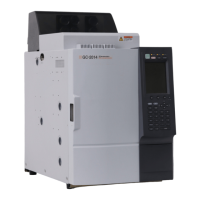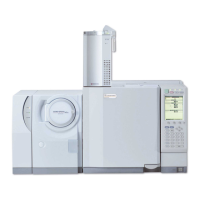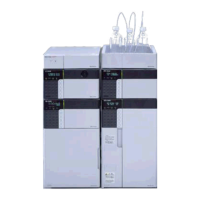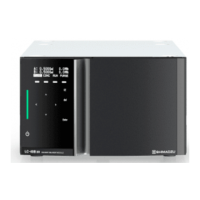89
4.5 O-ring for glass insert
4
4.5 O-ring for glass insert
If you are using capillary column
Purpose of inspection
Replace O-ring each time when replacing glass insert to prevent carrier gas leaks.
Replacing O-ring
Take out the glass insert, remove the O-ring, and install a new O-ring.
For removing/installing procedures of glass insert, refer to the following section, "4.6 Glass insert" P. 91.
(1)
Fluoride rubber O-ring
Place the Fluoride rubber O-ring temporarily at approx. 4 mm from the top of the glass insert.
When inserting into the injection port, push the glass insert until it touches the bottom of the injection
port.
This will fix the O-ring at 3 mm from the top of the glass insert.
(2)
Graphite O-ring
Insert the glass insert into the injection port, place a graphite O-ring over it, and then tighten the glass
insert nut.
A suitable graphite O-ring differs according to the type of glass insert. ALWAYS use an appropriate O-
ring for glass insert.
Leak check procedures
If the gas is leaking, you cannot obtain good analysis reproducibility, and also it may cause carrier gas
waste.
Make sure there is no leakage in the instrument by the following procedures.
(1)
On the [SYSTEM] key main screen (the screen which appears if you press [SYSTEM] key), set "Flow
Control" to "Cont".
(2)
Press [Stop GC] (PF1 key) to turn off the system.
(3)
On the [MONIT] key main screen, wait until the temperatures of column oven, injection port, and
detector all drop below 40C.
(4)
Press [On/Off] (PF3 key) on the [FLOW] main screen to turn off the AFC control.
Specify the purge flow rate to "0 ml/min".
(5)
Remove column, and cover the mounting port with graphite ferrule and column nut.
(6)
Install the blind (G-type blank nut) to the split vent and purge vent port.
(7)
Verify the supply pressure of carrier gas (the pressure from gas cylinders) is 300 kPa and above.
(8)
On the [FLOW] key main screen, set "Split mode" to "DIRECT" and "Control mode" to "PRESS".
(9)
Specify the inlet pressure to 150 kPa, and press [On/Off] (PF3 key) to turn on the AFC control.
(10)
5 minutes later, verify the inlet pressure is between 125 to 175 kPa. If it is above 175 kPa, slightly
loosen the column nut to reduce the pressure. If below 125 kPa, adjust to the higher supply pressure.
CAUTION
Handle graphite O-ring with strict care to avoid cracks or deformation.
CAUTION
During the checking process, the message "Purge leaks" etc. may appear. However, it does not affect
the performance. Select "Reset Error".
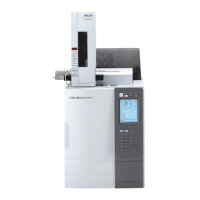
